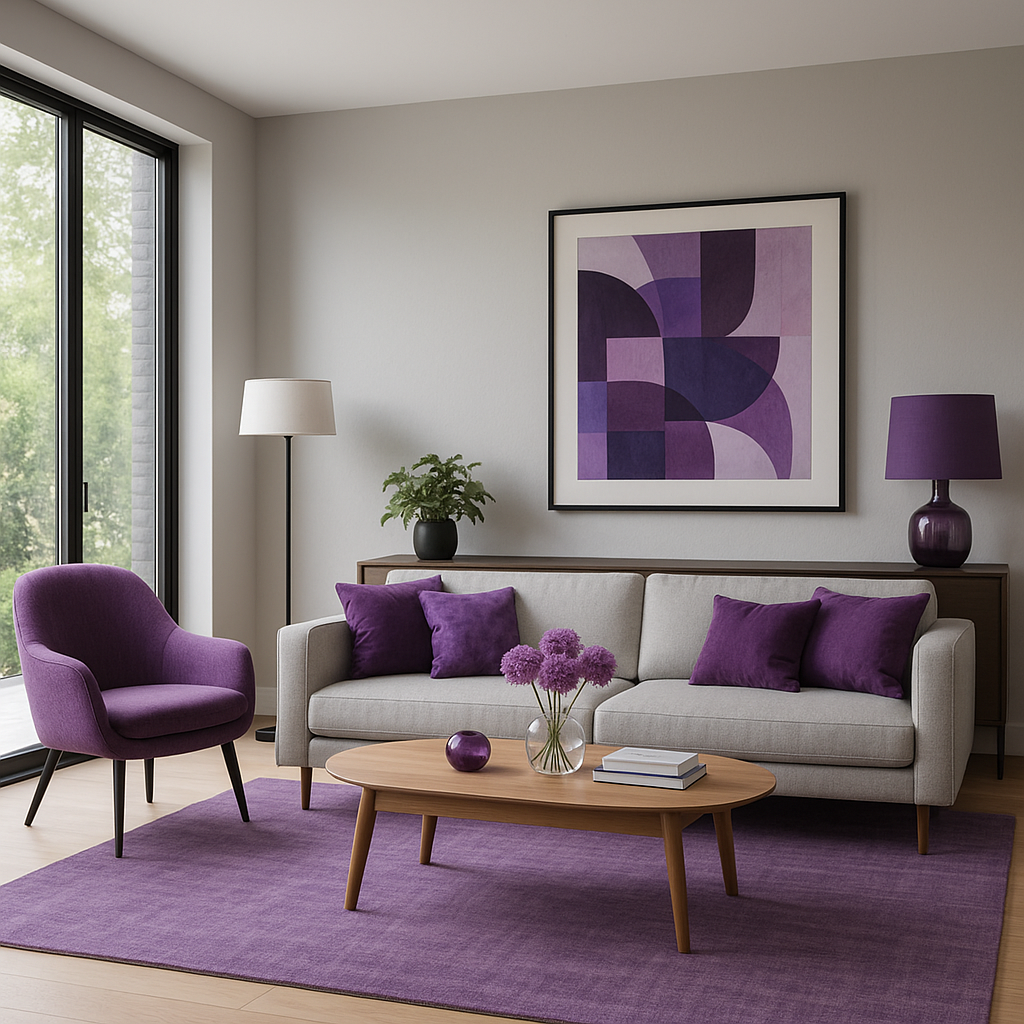I’ll show you how to transform your living room with purple without breaking the bank or making costly mistakes. Purple might seem intimidating, but I’ve discovered simple techniques that’ll help you create a sophisticated space using affordable materials and strategic color placement. Whether you’re working with a tight budget or planning a complete makeover, there’s a specific approach that determines whether your purple living room becomes a stunning success or an overwhelming disaster.
Key Takeaways
- Choose deep purple accent walls paired with warm neutrals to create dramatic focal points without overwhelming the space.
- Layer multiple purple shades through removable pillow covers, throws, and accessories for easy, budget-friendly color updates.
- Install statement purple lighting fixtures like pendant lights or chandeliers to add bold sophistication and visual interest.
- Use advanced painting techniques like glazing or marble effects to create unique textured purple walls with depth.
- Apply the 60-30-10 color rule with purple as accent color, balancing with whites and grays for breathing room.
Why Purple Is Dominating 2025 Interior Design Trends
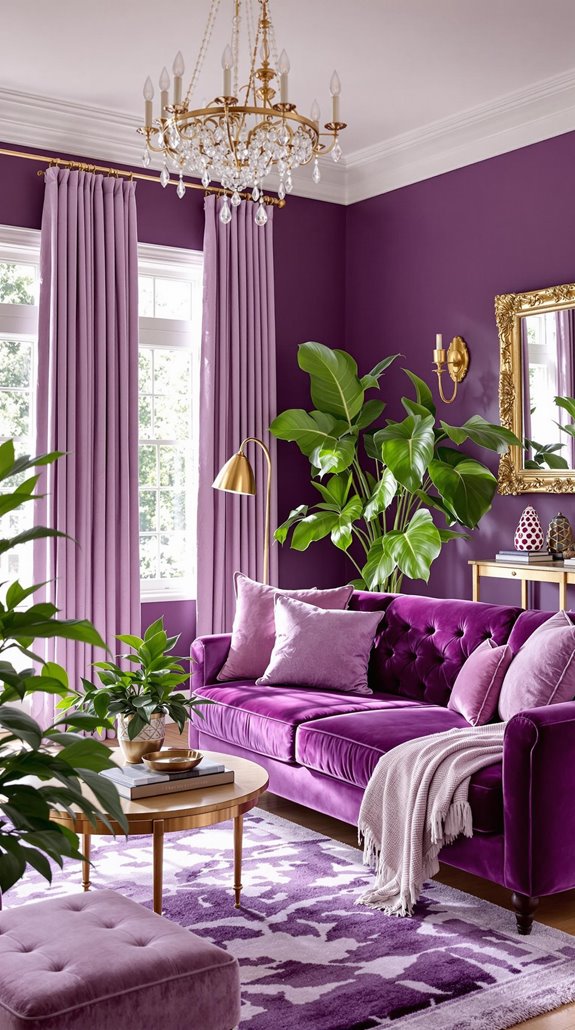
While neutral palettes dominated living rooms for years, 2025 marks purple’s breakthrough as the year’s most influential color choice. I’ve watched major paint brands like Benjamin Moore, Sherwin-Williams, and Behr all launch purple-centric collections, making this trend accessible across every budget.
You’re part of a movement rejecting sterile minimalism for “dopamine décor” that actually boosts your mood. Purple delivers both bold self-expression and comforting warmth—exactly what we need in our post-pandemic homes. Whether you choose dusty burgundy for nostalgia or deep cosmic purples for drama, you’re getting versatility that works with existing neutral pieces.
The best part? Purple pairs beautifully with trending earthy tones like Pantone’s “Mocha Mousse,” so you won’t need a complete room overhaul to join this vibrant revolution. For maximum impact, consider color drenching your entire space in a single purple shade, including ceilings and trim for a cohesive, dramatic effect.
Choosing the Perfect Purple Shade for Your Living Room
How do you navigate purple’s vast spectrum to find your living room’s perfect match? I’ll guide you through the key considerations that make this choice easier and more strategic.
Start by evaluating your space’s natural light and size. Light purples like lavender create an airy, spacious feel while offering soothing relaxation vibes. They work beautifully as neutral replacements when paired with other soft hues. For drama seekers, deep purples transform larger rooms into immersive, cozy retreats—especially effective in color-drenched applications.
Consider your style goals too. Pair light purples with crisp whites for fresh, clean aesthetics. Combine dusty plums with warm neutrals for timeless elegance. Want maximalist energy? Mix deep purples with other bold, warm colors. Purple’s psychological associations with creativity and luxury make it particularly effective for creating spaces that feel both inspiring and sophisticated. Always test samples under your specific lighting conditions before committing to verify the undertones complement your space perfectly.
The Psychology Behind Purple in Home Decor
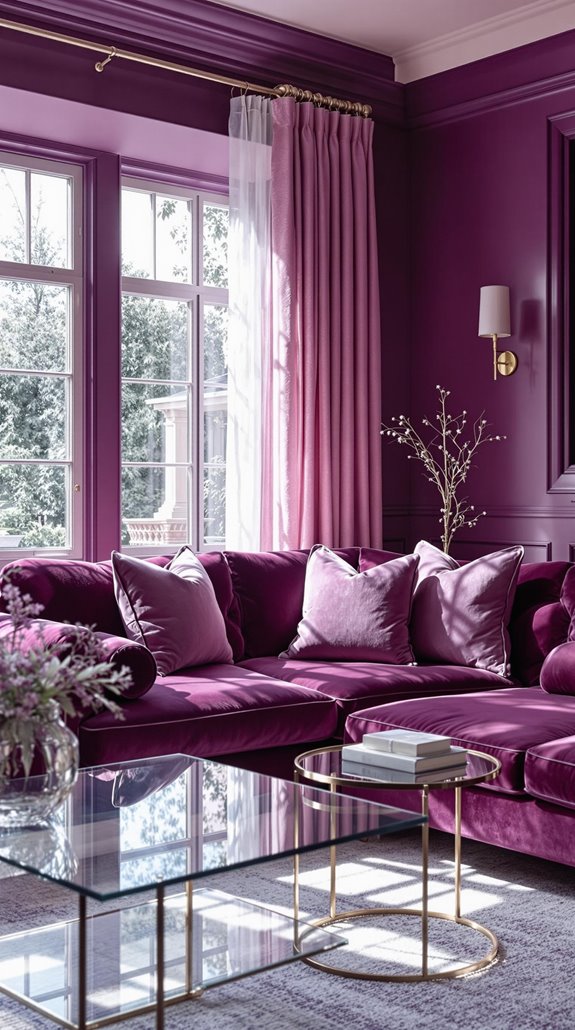
Beyond selecting the right shade, understanding purple’s psychological impact helps you create spaces that truly serve your needs and budget. I’ve found that purple’s unique blend of calming blue and energizing red makes it perfect for living rooms where you want both relaxation and stimulation. Additionally, property deal packaging is an excellent way to invest in your home while adding personal touches that reflect your style.
Light purples like lavender create dreamy, tranquil atmospheres that help reduce anxiety—ideal if you’re working with a tight budget but need maximum impact. Deep plums command attention as affordable focal points, instantly adding luxury without expensive renovations.
Purple stimulates creativity and confidence, making your space feel distinctly yours. It bridges emotional and logical states, perfect for family gatherings or quiet evenings. When you choose purple, you’re creating a sanctuary that supports both mindfulness and inspiration. This color’s historical association with royalty and wealth continues to elevate any room’s sophistication level.
Advanced Color Application Techniques for Purple Walls
Three professional techniques can transform your purple walls from basic paint jobs into stunning focal points without hiring expensive contractors. One effective method includes considering the maximum allowable extension sizes of your space when choosing your design elements.
I’ll start with fluid art marble technique using an affordable recipe: 50% Floetrol, 25% gloss medium, 25% acrylic paint. Layer colors like light blue, custom purple, and violet, then pour for organic marbled patterns. Add iridescent paints for shimmer effects.
Next, avoid dull purple mixes by using Quinacridone Magenta and Ultramarine Blue. Skip paints with hidden yellow pigments that create gray tones.
For glazing depth, try sponging translucent glaze over your purple base coat. Use sea sponges for cloud-like impressions or stippling for texture. Always check compatibility with space before selecting your specific glazing technique.
Finally, texture tools like iron scrubbers create gorgeous patterns. I’ve seen beginners achieve cherry blossom effects with simple household scrubbers.
Perfect Color Combinations That Complement Purple
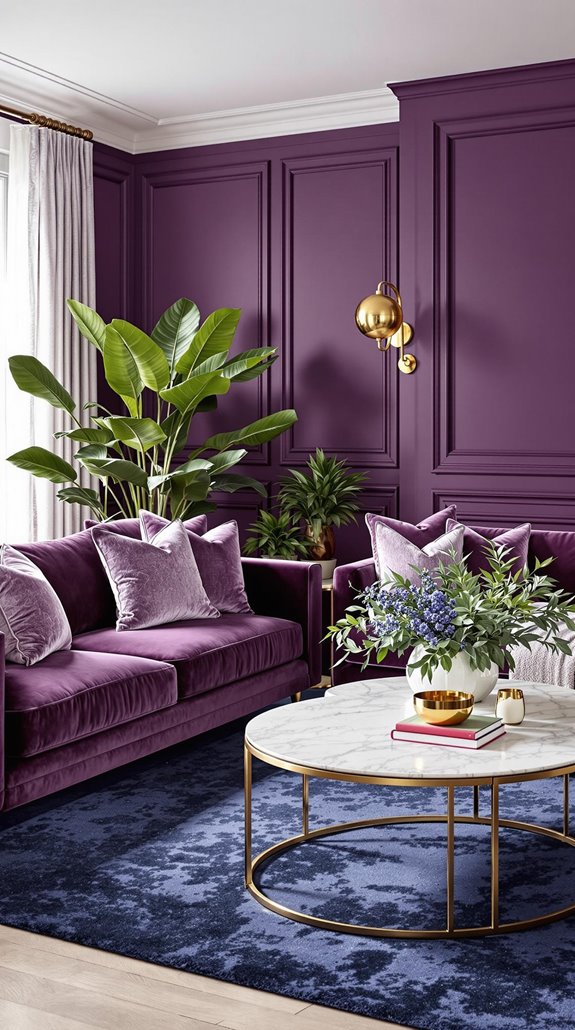
Since purple can easily overwhelm a room or clash with existing decor, I’ve found that strategic color pairing transforms it from risky to remarkable. I always recommend starting with classic neutrals like crisp white or soft gray—they’ll make your purple pop without breaking the budget.
For bolder combinations, I pair deep purples with sage green or navy blue. These create sophisticated depth that feels intentional, not accidental. When working with lighter shades like lilac and lavender, I add warm gold accents through thrift store finds or DIY spray-painted frames. Remember that purple changes dramatically under different lighting conditions, so always test your chosen combinations in various light throughout the day.
My go-to formula: choose one dominant purple shade, add two neutrals for balance, then introduce one accent color sparingly. This approach keeps costs manageable while creating that designer look we’re all after.
Essential Materials and Textures for Purple Living Rooms
While color sets the mood in purple living rooms, texture creates the magic that makes spaces feel expensive on any budget. I’ll show you how to layer materials that transform ordinary spaces into designer showrooms.
Start with grasscloth wallpaper—it adds organic texture and subtle sheen that elevates purple walls instantly. For furniture, I recommend velvet upholstery on your sofa; it absorbs light beautifully, creating rich jewel-tone depth. Balance this luxury with budget-friendly jute rugs and reclaimed wood coffee tables that add earthy warmth. Additionally, consider incorporating affordable heating solutions like log burners, which can enhance comfort during colder months without breaking the bank.
Here’s my favorite trick: pair glossy lacquered walls with matte velvet sofas. This contrast creates dynamic light play that looks professionally designed. Layer in linen cushions, knitted throws, and hammered metal accents to complete your textural story. Reflective surfaces strategically placed throughout the room will enhance both light and color while creating the illusion of more space.
Small Changes That Make a Big Purple Impact
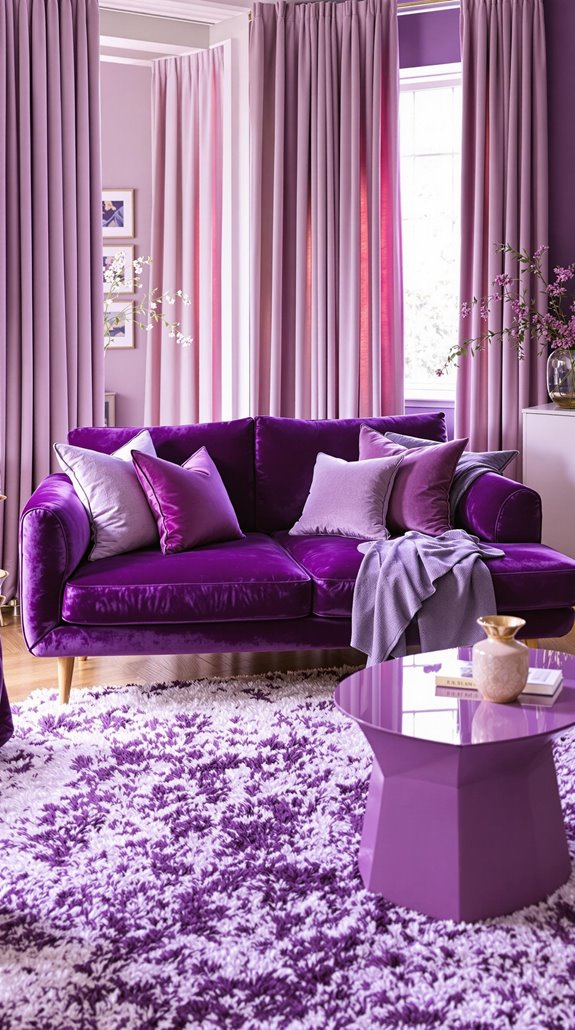
Before you consider major renovations, strategic purple accents can transform your living room in a single afternoon. I recommend starting with removable pillow covers in lilac or plum—they’re budget-friendly and instantly revitalize neutral sofas. You’ll create immediate impact by layering multiple purple-toned throws across your seating.
For wall transformation, I suggest downloadable abstract art with lavender tones framed in black. This approach costs less than $50 and creates dramatic focal points. Add purple glassware as tabletop centerpieces—vases and ceramic bowls in eggplant tones serve double duty as functional decor. Incorporating budget-friendly tips can help you achieve a cohesive design without breaking the bank.
Balance bold hues by pairing purple accents with jute rugs and wooden elements. Mixing wood tones helps ground the purple color scheme and prevents it from feeling overwhelming. Mix at least three purple shades—lilac, mauve, and eggplant—across pillows, art, and accessories to avoid flat monochromatic looks.
Lighting Strategies to Enhance Purple Interiors
Although purple fixtures might seem intimidating, they’re actually versatile tools that’ll amplify your room’s drama without breaking your budget. I recommend starting with one statement piece—perhaps a purple pendant light or chandelier—then building around it with neutral anchors like linen cushions or wood textures.
You’ll want to balance natural light with warm-white bulbs to prevent your purple scheme from feeling cold. I suggest installing dimmers so you can adjust intensity based on your mood. Position fixtures strategically to illuminate corners evenly, avoiding harsh shadows that’ll make deep purples appear overwhelming.
For maximum impact, layer your lighting with overhead, task, and accent options. Combine light lavender with deeper plum tones, and use metallic accents to create sophisticated contrast that welcomes guests into your transformed space. Consider room size and ceiling height when selecting your purple fixtures, as these factors will determine whether a flush mount or grand chandelier works best for your space.
Common Purple Decorating Mistakes to Avoid
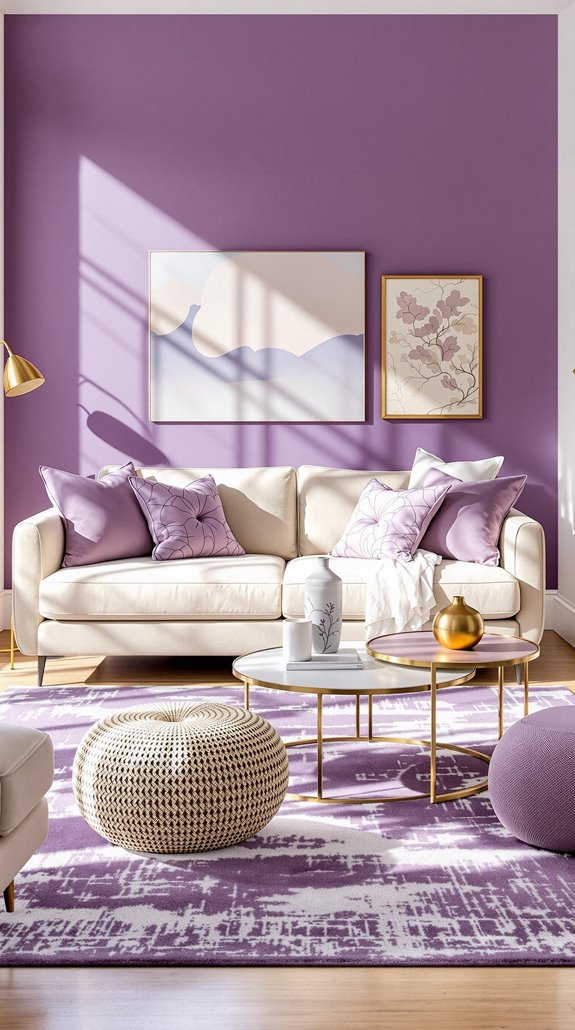
When designers rush into purple schemes without proper planning, they often create spaces that feel chaotic rather than luxurious. I’ve seen countless homeowners overlook purple’s undertones, pairing cool blue-based purples with warm red-based ones, creating visual discord. You’ll avoid this by testing paint samples under different lighting conditions before committing. Additionally, consider the associated renovation costs that can arise when implementing bold color choices in your home.
Don’t saturate your entire room with purple—it overwhelms the senses and eliminates focal points. Instead, use the 60-30-10 rule: neutral base, purple as secondary, and accent colors sparingly. I recommend balancing intense purples with breathing room through whites or grays.
Consider your room’s function too. Dark purples make small spaces feel oppressive, while bright purples in bedrooms overstimulate. You’ll create harmonious spaces by respecting color psychology and choosing complementary pairings like purple with soft yellows or analogous blues. Remember that personal reactions to purple vary significantly, so what feels regal and sophisticated to one person may feel overwhelming to another.
Conclusion
I’ve shown you practical ways to transform your living room with purple without breaking the bank. Start small with affordable throw pillows and artwork, then gradually add deeper purple elements as your budget allows. Focus on lighting that enhances your chosen shade, and don’t forget those essential neutral balancing pieces. With these budget-friendly strategies and color techniques, you’ll create a stunning purple sanctuary that reflects your personal style perfectly.
References
- https://www.housebeautiful.com/uk/decorate/g63781984/decorating-with-purple/
- https://www.homesandgardens.com/interior-design/is-purple-making-a-comeback
- https://virginialiving.com/house-garden/2025-trends-include-purple-and-dopamine-decor/
- https://www.livingetc.com/ideas/living-room-color-trends-2025
- https://uk.pinterest.com/pin/699535754607517197/
- https://www.thenordroom.com/color-trends-2025/
- https://www.elephantstock.com/blogs/inspiration/10-mind-blowing-interior-design-trends
- https://www.letstalkpaintcolor.com/post/2025-color-and-design-trends
- https://www.housebeautiful.com/design-inspiration/a63147733/stylish-interior-design-trends-2025/
- https://www.youtube.com/watch?v=MCYGQcLPTIY

